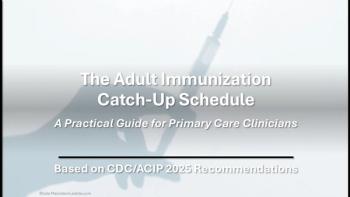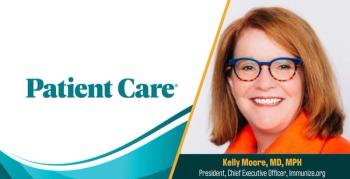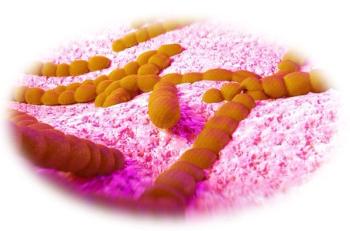
Herpes Zoster Virus Infection in a Young Woman
The mother of a 6-year-old child brings her to your office becauseof a pruritic rash that has been present for several days. The rash did not respondto hydrocortisone cream and has continued to spread along the patient’sleft side.
THE CASE: The mother of a 6-year-old child brings her to your office becauseof a pruritic rash that has been present for several days. The rash did not respondto hydrocortisone cream and has continued to spread along the patient'sleft side.
What is the likely cause of the child's rash?
- Smallpox.
- Vaccinia.
- Herpes zoster virus infection (shingles).
- Eczema herpeticum.
- Poison ivy.
Figure 1
Figure 2
DISCUSSION: The dermatomal distributionof this rash (T12 to L3) ischaracteristic of herpes zoster virus infection.The rash begins as a localizedarea of maculopapular lesions on anerythematous base and soon progressesto grouped vesicular lesions that involveseveral sensory dermatomes(Figure). These lesions are unilateraland rarely cross the midline. Bullouslesions occasionally appear; these representa secondary bacterial infectionwith an exfoliative toxigenic Staphylococcusaureus.
Patients with herpes zoster virusinfection usually experience a severaldayprodrome of headache, fever,malaise, and dysthesia before theskin lesions appear. New lesions mayerupt for several days; resolution usuallyoccurs in 10 to 15 days. Unlikeadults, who often suffer constant, intenseneuritis, children with herpeszoster usually experience only minimaldiscomfort.
On further questioning, this patient'smother reported that she hadhad varicella shortly after delivery.Primary maternal varicella virus infectionat the time of delivery is associatedwith a significant risk of neonatalinfection (especially pneumonia);however, there is no increased risk ofcomplications from herpes zoster ifmaternal infection occurs more than2 days after delivery.
Recommended treatment forchildren is oral acyclovir, 20 mg/kg/dose (maximum, 800 mg), 5 times aday for 7 to 10 days. Immunocompetentpatients need not be treated ifdiagnosis is made 72 hours or morefrom rash onset; however, immunocompromisedpatients must be treated.Postherpetic neuralgia is uncommonin children, and the useof corticosteroids is not routinelyrecommended.
Herpes zoster, which representsreactivation of latent infection,rarely occurs in children youngerthan 15 years. A thorough maternalhistory is crucial. If the mother andchild have no history of varicellaand the child is otherwise normal,concern about the child's immunestatus is warranted. Herpes zoster inimmunocompromised children canbe severe.
Smallpox (variola) was last detectedin Somalia in 1977. The lesions,which characteristically progress frommacules to vesicles to crusting, primarilyaffect the distal limbs, includingthe palms and soles. With the recentincrease in the potential for incidentsof biologic terrorism, one must keepthis disease in the differential.
Vaccinia-the cutaneous (andsometime systemic) reactions associatedwith vaccination with smallpoxvaccine-is morphologically indistinguishablefrom smallpox. Vacciniamay produce lesions similar to thoseof varicella.
The lesions of eczema herpeticumare localized vesicular eruptionscaused by herpes simplex virus infection.A more invasive (but still localized)form of this disease may occurin persons with underlying atopic dermatitis,eczema, or other cutaneousinjury.
Poison ivy, which is generallyassociated with exposure to woodedareas, typically produces pruritic,linear, vesicular lesions with an erythematousbase.
FOR MORE INFORMATION:
- Arvin AM. Antiviral therapy for varicella and herpeszoster. Semin Pediatr Infect Dis. 2002;13:12-21.
- Gershon AA, Mervish N, LaRussa P, et al. Varicella-zoster virus infection in children with underlyinghuman immunodeficiency virus infection. J Infect Dis.1997;176:1496-1500.
- Gnann JW Jr, Whitley RJ. Clinical practice. Herpeszoster. N Engl J Med. 2002;347:340-346.
Newsletter
Enhance your clinical practice with the Patient Care newsletter, offering the latest evidence-based guidelines, diagnostic insights, and treatment strategies for primary care physicians.

































































































































































































































































































